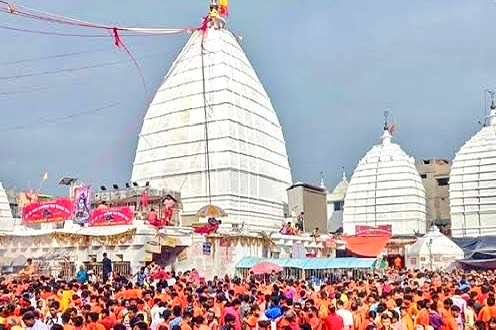Omkareshwar Jyotirlinga
Omkareshwar Temple History
Location: Omkareshwar is situated on the Mandhata Island in the Narmada River in the Khandwa district of Madhya Pradesh, India.
Significance:- The temple is one of the 12 Jyotirlingas, which are considered sacred representations of Lord Shiva.
- Jyotirlinga:
- Omkareshwar is home to one of the 12 Jyotirlingas, which are considered to be self-manifested representations of Lord Shiva. These Jyotirlingas hold immense spiritual significance in Hinduism.
Lord Shiva’s Abode:- The temple is dedicated to Lord Shiva, and the presiding deity is worshipped in the form of the Omkareshwar Jyotirlinga. Devotees visit to seek the divine blessings of Lord Shiva.
Sacred Island:- Omkareshwar is located on Mandhata Island in the Narmada River, and the island itself is considered sacred. The geographical setting adds to the spiritual ambiance of the place.
Narmada Parikrama:- Omkareshwar is a crucial point on the Narmada Parikrama pilgrimage route. Pilgrims circumambulate the Narmada River as an act of devotion, and Omkareshwar holds significance along this sacred journey.
Integration of Shaivaite Traditions:- The temple reflects a fusion of Nagara and Dravidian architectural styles, symbolizing the unity of different Shaivaite traditions within Hinduism.
Mamleshwar Temple:
- The presence of the Mamleshwar Temple on the opposite side of the river adds to the temple complex’s spiritual importance. Pilgrims often visit both temples during their religious journey.
Aarti and Rituals:- Daily aarti ceremonies are performed in the temple, enhancing the spiritual atmosphere. Festivals like Mahashivratri are celebrated with elaborate rituals.
Parikrama Marg:- The Parikrama Marg, a pathway around the island, is walked by devotees as a part of their spiritual practice and devotion.
Omkareshwar’s significance lies not only in its religious heritage but also in its tranquil surroundings, making it a revered destination for devotees and seekers of spiritual experiences
Architecture: The temple exhibits a blend of Nagara and Dravidian architectural styles. The main sanctum houses the Jyotirlinga.
Mamleshwar Temple:- Omkareshwar is associated with another temple called Mamleshwar, located on the opposite side of the river. Pilgrims often visit both temples as part of their religious journey.
- Mandhata Island Location:
- The temple is situated on Mandhata Island in the Narmada River, and its geographical location contributes to the uniqueness of its architectural setting.
Jyotirlinga Sanctum:
- The main sanctum of the temple houses the Omkareshwar Jyotirlinga, the primary deity of worship. The sanctum is adorned with intricate carvings and sculptures.
Nagara and Dravidian Fusion:- The architecture seamlessly blends Nagara and Dravidian styles. The Nagara style is characterized by a curvilinear spire, while the Dravidian style is known for its pyramidal-shaped towers.
Temple Complex:- The temple complex includes multiple shrines, each with its unique architectural features. The structures are adorned with carvings depicting various mythological and religious themes.
Mamleshwar Temple Architecture:- The Mamleshwar Temple on the opposite bank of the river also exhibits architectural elements typical of Hindu temple design, adding to the overall aesthetic of the complex.
Stone Carvings:- Elaborate stone carvings adorn the walls of the temple, showcasing intricate designs, patterns, and depictions of deities and mythological scenes.
Pillars and Mandapas:- The temple features intricately carved pillars and mandapas (pavilions) that contribute to the overall architectural grandeur. These structures serve both functional and ornamental purposes.
River Ambiance:- The setting of the temple on an island in the Narmada River enhances the spiritual ambiance, providing devotees with a serene and picturesque environment.
The architectural richness of the Omkareshwar Temple reflects the historical and cultural influences that have shaped its design over the centuries. Pilgrims and visitors not only experience spiritual bliss but also marvel at the artistic and architectural beauty of this sacred site.
Narmada Parikrama:Omkareshwar is a significant point on the Narmada Parikrama pilgrimage route, where devotees circumambulate the Narmada River.
Parikrama Marg:- There is a pathway around the island known as Parikrama Marg, which devotees walk as part of their spiritual practice.
Aarti and Festivals:- Daily aarti ceremonies are performed in the temple. Festivals like Mahashivratri are celebrated with great enthusiasm.
- Omkareshwar Aarti and Festivals
Aarti at Omkareshwar Temple:- Morning Aarti (Pratah Aarti):
- Held early in the morning to invoke blessings for a successful and auspicious day.
Noon Aarti (Madhyahna Aarti):- Conducted during the afternoon, symbolizing devotion and gratitude.
Evening Aarti (Sayan Aarti):- Performed in the evening as a part of the daily worship ritual.
Shayana Aarti (Night Aarti):- The final aarti of the day, conducted before the deity retires for the night.
Festivals Celebrated at Omkareshwar Temple:
- Mahashivratri:
- Celebrated with great enthusiasm and devotion. Devotees throng the temple to offer special prayers and participate in night-long celebrations.
Shravan Month:- The holy month of Shravan witnesses increased footfall as devotees undertake special pilgrimages and offer prayers to Lord Shiva.
Narmada Jayanti:- Celebrated to honor the Narmada River, with special ceremonies and rituals performed along its banks.
Kartik Purnima:- Devotees visit the temple during Kartik Purnima, considered auspicious for performing rituals and taking a holy dip in the Narmada River.
Holi:- The festival of colors is celebrated with joy and fervor. Devotees come together to celebrate the victory of good over evil.




animi est eum dolores repellendus incidunt quae nemo eum pariatur perferendis. similique atque nostrum ullam eum voluptatem officia doloribus hic totam commodi omnis ut qui. deleniti quas tempore reprehenderit labore quos qui repellendus aut est ipsam sed nobis. ex quis sunt temporibus voluptas sint sunt porro maiores numquam natus facilis laborum maiores. ut eligendi impedit perspiciatis eum mollitia aut necessitatibus similique velit.
impedit mollitia voluptatem sint assumenda sunt ab dolorem eligendi consequatur qui tempore magnam ipsam omnis. voluptas ea aliquid ut et aut facilis impedit voluptas ullam aut aut ut voluptate. eaque rerum dolor soluta at quia architecto et inventore sit est consectetur voluptatibus dolorum. quia temporibus ut ullam sit dolorum fugit accusamus quae quibusdam voluptas officiis repudiandae et aut et vero ut fuga. soluta quod dolorem qui deleniti vel occaecati id sunt.
voluptas aspernatur error non asperiores ipsam quo. sed dignissimos vero eaque officia quaerat illum qui consequatur ducimus fuga est delectus quo corrupti. ea autem officia neque qui pariatur et sed eos aut ab sit. nam eum rerum id similique pariatur velit ut qui ex ullam rem et delectus est aperiam.
sit sequi est libero quo quas necessitatibus. cupiditate repellendus cum ut ut consectetur. ipsa aut ea quasi libero placeat.